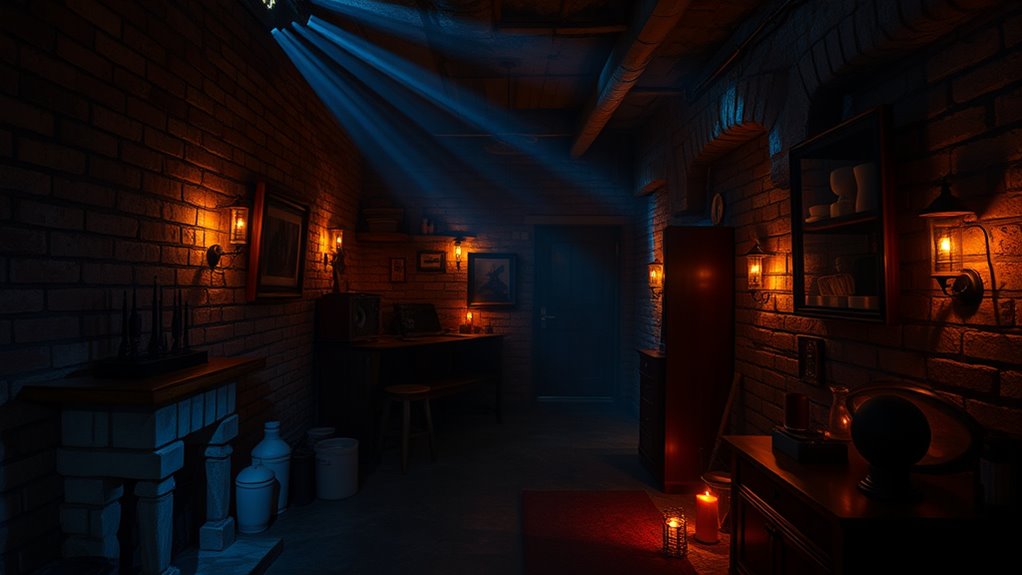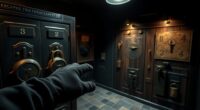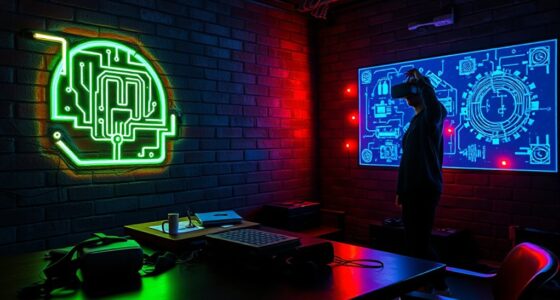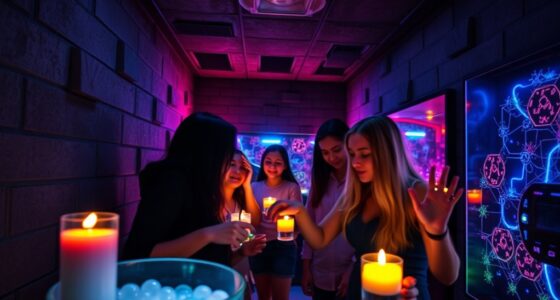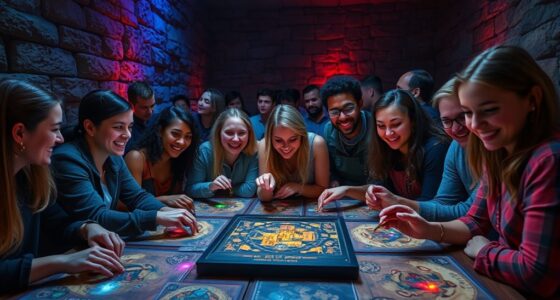Lighting and sound play a crucial role in creating an immersive escape room experience. They set the mood with flickering lights, colors, and ambient noises that evoke emotions like suspense, curiosity, or calmness. These sensory cues guide your attention, influence behavior, and support storytelling and puzzles. When used together, lighting and sound deepen realism and heighten your emotional engagement — if you want to discover how they craft unforgettable adventures, keep exploring.
Key Takeaways
- Lighting sets the mood and guides attention, enhancing storytelling and emotional engagement in escape rooms.
- Sound effects create realism, signal cues, and heighten suspense, deepening immersion.
- Synchronizing lighting and sound amplifies atmosphere, making scenarios more believable and intense.
- Visual and auditory cues influence player behavior and perception, aiding puzzle-solving and navigation.
- Strategic use of sensory elements sustains focus, builds tension, and transforms puzzles into memorable experiences.
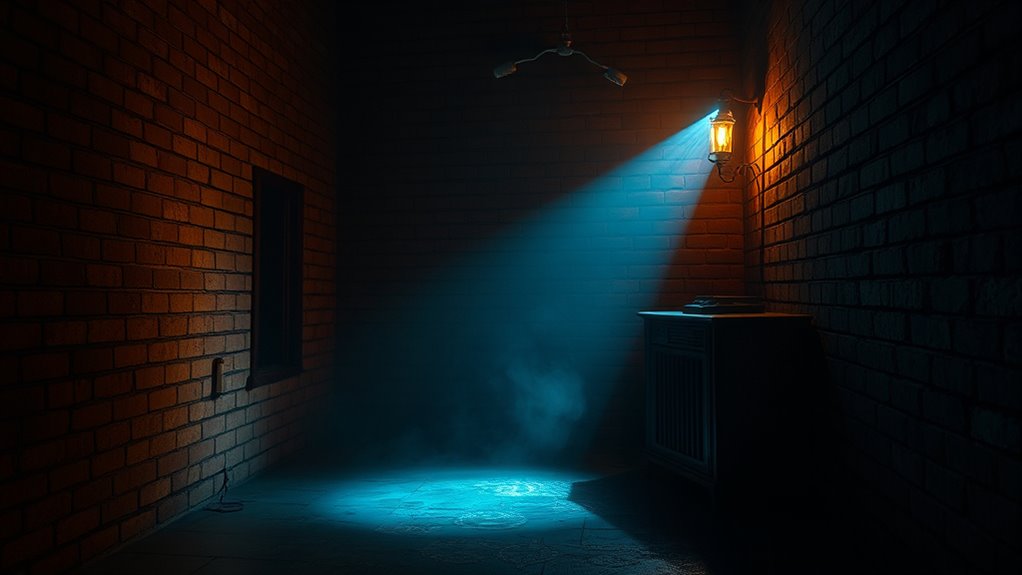
Lighting and sound are essential elements that can make or break the immersive experience of an escape room. When you step into a well-designed room, the right combination of these elements instantly pulls you into a different world. Visual effects, such as dim lighting, flickering bulbs, or colored lights, help create a compelling ambient atmosphere that heightens your sense of mystery and tension. You might notice how subtle changes in lighting evoke different emotions—soft, warm tones can make the environment feel cozy or nostalgic, while harsh, cold lighting can generate unease or urgency. These visual effects are carefully curated to complement the story and puzzles, guiding your attention and shaping your perception of the space. They also influence your mood, making you feel more engaged and immersed in the narrative. The ambient atmosphere, crafted through a combination of lighting and visual effects, acts as an emotional backdrop that sustains your focus and heightens your senses. Additionally, the strategic use of personality traits can influence how players respond to various scenarios, enhancing the overall experience.
Sound plays an equally critical role in elevating the experience. Dynamic soundscapes, including eerie background noises, whispers, or distant footsteps, reinforce the environment’s realism. When ambient sounds are synchronized with lighting cues, they create a seamless sensory flow that keeps you alert and immersed. For example, a sudden crescendo of sounds might signal an approaching challenge or danger, prompting you to react quickly. The use of sound effects can also serve as subtle clues—like a ticking clock hinting at a time-sensitive puzzle—or as atmospheric enhancements that deepen the story. You’ll find that audio cues shape your emotional response, intensifying feelings of suspense, excitement, or curiosity. When combined with ambient lighting, sound enhances the overall atmosphere, making you feel as if you’ve truly entered a different world.
In an escape room, everything works together to craft a cohesive and believable environment. Visual effects and ambient atmosphere don’t just serve aesthetic purposes—they’re strategic tools that guide your behavior and perceptions. By manipulating light and sound, designers can create a sense of realism, urgency, or tranquility, depending on what the scenario demands. When these elements are executed effectively, they keep you engaged from start to finish, heightening the thrill of discovery and problem-solving. So, next time you’re immersed in an escape room, pay close attention to how lighting and sound influence your experience—they’re the unsung heroes that turn a simple puzzle into an unforgettable adventure.
Frequently Asked Questions
How Do Lighting Effects Influence Player Emotions?
Lighting effects markedly influence your emotional impact and mood setting in escape rooms. Bright, warm lights create feelings of safety and comfort, while dim, flickering lights build tension and suspense. Strategic lighting guides your focus, heightening curiosity or fear. When you notice changing lighting, it triggers emotional responses, making the experience more immersive. You’ll feel more engaged, anxious, or excited, depending on how the lighting manipulates the room’s atmosphere.
What Are the Latest Sound Technology Innovations in Escape Rooms?
You’ll find the latest sound tech innovations in escape rooms focus on surround sound and immersive audio, enhancing realism and engagement. These systems use 3D audio, spatial sound, and directional speakers to create a seamless auditory environment. You’ll experience sounds that move with your actions, deepen the storyline, and heighten suspense. This technology transforms ordinary spaces into fully immersive worlds, making every whisper, footstep, and clue feel startlingly real.
Can Lighting and Sound Be Customized for Different Themes?
Yes, lighting and sound can be customized for different themes, enhancing the overall experience. You can adjust lighting and sound effects through technical customization to match your escape room’s theming consistency, creating a more immersive environment. By tailoring these elements, you guarantee that every detail aligns with the storyline, making the experience more engaging and believable for participants. This customization helps you deliver a seamless, thematically cohesive adventure.
How Do Escape Rooms Ensure Accessibility for All Players?
Escape rooms guarantee accessibility for all players by offering visual accessibility options like adjustable lighting and high-contrast visuals, making it easier for those with visual impairments to participate. They also provide auditory assistance, such as subtitles or visual cues, to support players with hearing challenges. By incorporating these features, they create an inclusive environment where everyone can enjoy the challenge and immerse themselves fully in the experience.
What Safety Measures Are in Place for Lighting and Sound Equipment?
You notice the flicker of lights and subtle sounds, but safety is always at the forefront. Regular equipment maintenance and thorough inspections prevent fire hazards, ensuring nothing sparks unexpectedly. Emergency shut-off switches are within reach, ready to cut power instantly if needed. You’re reassured knowing strict safety protocols protect you, minimizing risks from lighting or sound malfunctions so you can focus on solving the escape without worry.
Conclusion
Lighting and sound work together to create an immersive escape room experience. They set the mood, guide your actions, and heighten your emotions. When lighting surprises you, sound energizes you; when sound calms you, lighting soothes you. By blending these elements seamlessly, you stay engaged, stay alert, and stay immersed. Ultimately, lighting and sound aren’t just backgrounds—they’re the heartbeat of your adventure, transforming a simple room into an unforgettable journey.
